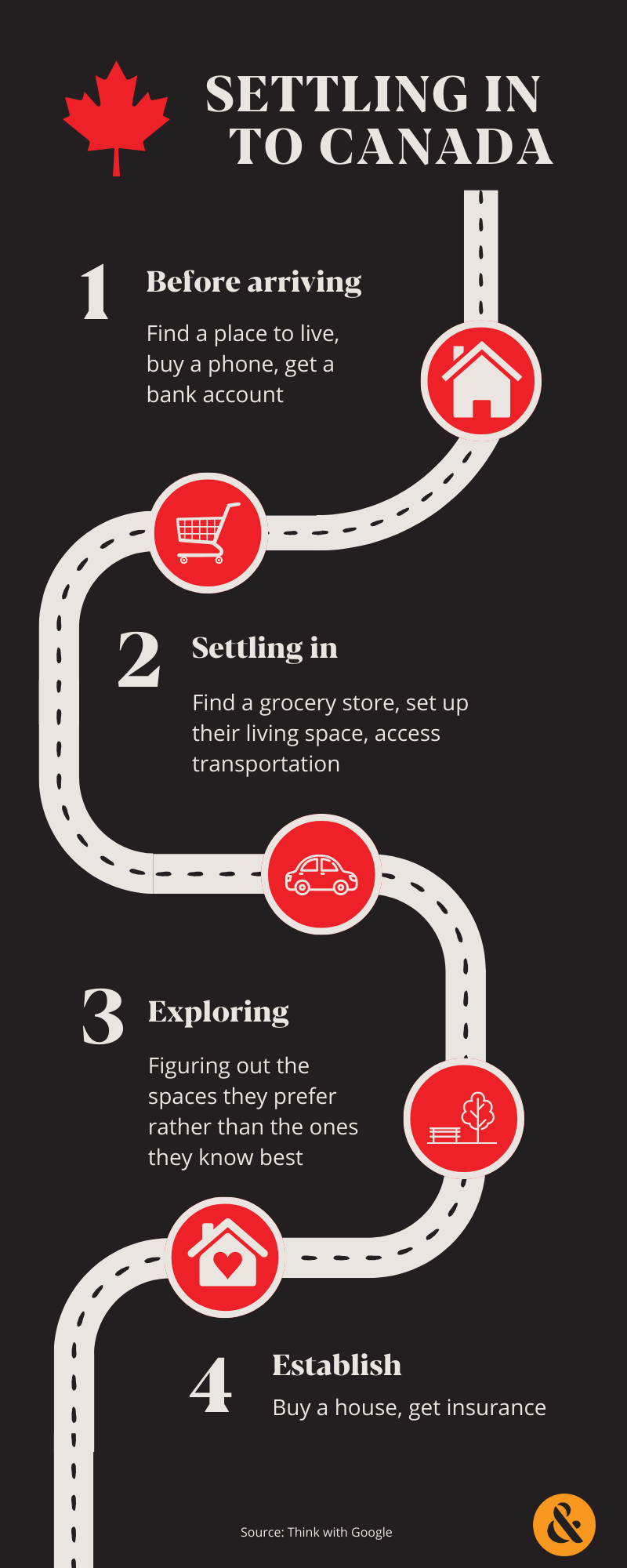

Canada has long been known for the melting pot of cultures and backgrounds of its people and this only continues to be the case as immigration numbers rise. According to Statista, annual immigration in Canada amounts to almost 500,000 new immigrants – one of the highest rates per population of any country in the world. As of 2023, there were more than eight million immigrants with permanent residence living in Canada – roughly 20 percent of the total Canadian population.
And with this many newcomers, there is a need for established Canadians and established Canadian brands to understand the behaviours, desires, and intricacies of immigrants to help meet needs and answer any questions they may have as they discover what their new lives will look like.
Right away, there needs to be an understanding that immigrants are not a monolith, much like Canadians have never been. When we look at where we are seeing growth, Ontario leads the pack with almost 200,000 immigrants in 2023, however, all provinces and territories (other than Northwest Territories) saw population growth over the course of the year. And as to where they are immigrating from, over half are from Asia with the highest number being from India, China, and the Philippines with high numbers also coming from outside of Asia in Afghanistan and Nigeria.

It should be noted as well that more than 21,000 Ukrainians have arrived in Canada since the ongoing conflict with Russia began. However, they arrived under temporary emergency visas and are removed from many of the immigration stats found online. However, in the same vein as all immigrants, established Canadians and brands need to understand how best to communicate and meet the needs of this new group.
Branding for New Canadians
One of the most important things for brands to understand about immigrants is that brand awareness will be at an all-time low. Where established Canadians will have grown up with an understanding of North American brands, immigrants will have very little understanding of not only the difference between each brand but which one is most like what they are used to. 67% of immigrants say the Canadian shopping experience is vastly different from their country of origin.
For example, your choice of peanut butter is likely the same one you’ve had since you were young. But North American peanut butters have a higher sugar content and are much sweeter than international varieties. Even within North America there are differences where in the US it must have at least 90% peanuts to identify as such, Canada has no such law. Therefore, not only does each new immigrant face the problem of finding the brand they prefer, but the certain variety that suits their taste as well.
In fact, food consumption is one of the major issues that new Canadians face with these intricacies at the forefront. Much research has been done into these habits and the founding of the Healthy Immigrant Effect. Dietary acculturation is a process by which minority groups adopt the dietary patterns of their host country – often leading to a less-healthy lifestyle than they are used to from their former environment.
Barriers include limited availability of traditional ethnic ingredients, inadequate understanding of the new food context, and language barriers, further affecting immigrants’ ability to adjust to the unfamiliar food context and navigate their way in managing healthy food choices. Brands that understand the intricacies of choice and the difficulties that immigrants face in not knowing the new landscape will be better equipped to reach this audience and gain loyalty.
And this isn’t just applied to the food landscape. All brands can take this kind of understanding and integrate it in their own businesses. After all, 59% of Canadians prefer to be associated with brands that align with their values, and diversity and inclusion is a key part of those values for many. Therefore, building more inclusion into your campaigns will not only help new Canadians understand your brand but help established Canadians understand your brand values better.
The Purchase Journey
Newcomers to the country may begin their purchase journey before they set foot on the soil, doing prior research into the larger purchases like where they will live and the schools they may be close by to attend. If you are a post-secondary institution, a realtor association, or a car dealership, your services and the communication of those services will be needed prior to landing in Canada. Understanding the start of the purchase journey and targeting early will help to ensure you have visibility and are there at the right moment.
For some industries like telecommunications, CPG, or financial services, immigrants are more likely to wait until they are within the country to begin their purchase journey and communicating to them early in this journey will be key.
According to Think with Google data, 75% use Search to guide how they navigate their new lives, 65% using word of mouth from friends and family, 63% using Canadian government websites, and 42% turning to social media. Marketers should know the mix of where and when to properly meet the needs of this new group.
And immigrants are open to your advertising more than established Canadians. Recognizing they will need to make new choices, they are 1.6x more willing to try new products, 1.3x more willing to try new brands, and 2.4x more attentive to ads with celebrity endorsements or local influencers. They need guidance to figure out what to buy and are more likely to latch onto the knowledge they do have to make those choices.
When we look at something like private label, many established Canadians have turned to purchasing due to the rising cost-of-living, however, younger Canadians and new Canadians perceive Private Label as being “average” and “poor” and are unlikely to choose them even if they are offered at a lower cost than National brands. This demographic is 64% more likely to shop at bulk stores in large quantities over $250 and 67% more likely to shop at local farmers markets to search for quality over price, unlike many current Canadian segments.

Advertisers must understand every intricacy of the purchase journey and inevitable decision to meet this segment where they are at. Targeting the same creatives or the same tactics on new Canadians will fall short or completely miss the opportunity they present for brands.
Navigating Your Campaigns
The first and most important piece of the puzzle is market and audience analysis. As mentioned before, each industry is going to fit into the immigrant’s journey differently and knowing where you fall will help establish your strategy. Once you know where you fall and who your specific audience is, you will need to figure out which tactics to apply.
Alongside your tactics, understand that creative will need to be unique to this segment and directly address their needs. 26% of newcomers surveyed that they became aware of brands through advertisements and the tactics in which they were delivered varies greatly by the country of origin. Even within tactics, there are intricacies to understand, for example 68% of Europeans prefer Cable TV, 30% of Middle Eastern Immigrants prefer satellite TV, and 39% of South Asian immigrants prefer IPTV.
When advertising, it is important to note as well that most immigrants are currently still in the process of learning English. Therefore, when you advertise, ensuring that your targets are precise you could create advertisements in different languages, presenting a lower barrier to entry for newcomers. It may also help to lean on creative that shows rather than tells why your product is superior to help toward this goal as well.
It is up to each advertiser to help new Canadians build confidence in their purchases and present marketing in a way that makes sense for them, rather than hoping this new segment is aware of the creative and tactics presented to established Canadians. There is a great opportunity here to push forward inclusive strategies that are helpful to newcomers and brands alike.